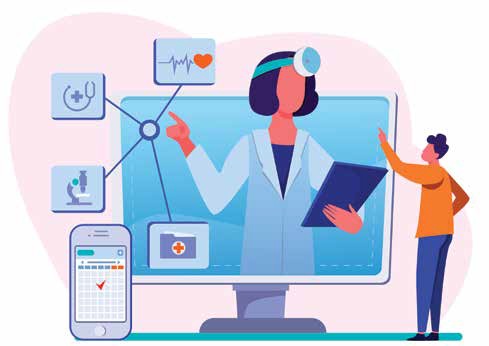COVID-19 has caused rapid digitalisation of the healthcare industry as providers seek to care for the sudden influx in patients and deliver routine critical care. One rising trend is AI as the industry moves away from a treatment and management approach to one focused on early detection and prevention.
Stretched, but coping. That is the stark reality today for healthcare systems around the world, that have been battling the COVID-19 pandemic for over a year with the severity and impact of the virus coming in peaks and troughs.
It is undeniable that the industry has been facing unprecedented stress as providers seek ways to deliver routine critical care amidst the sudden influx in patients. Adding to this challenge are nationwide manpower shortages, lack of healthcare access in remote areas and the risk of healthcare provider burnout – a staggering 72.7 per cent of healthcare professionals in Malaysia alone have reporting systems of burnout since the start of the COVID-19 pandemic.

The numbers are especially worrying when we consider the far-reaching consequences associated with burnout. These range from feeling distant toward work, a sense of resentment toward patients and the public, and overall lack of productivity, ultimately leading to decreased performance and poorer patient experiences and outcomes1.
Despite the constant change that is reshaping day-to-day realities of patients, health workers, healthcare organisations and providers, not all change is bad; COVID-19 has also spurred the accelerated adoption of digital technologies, leading to digitalisation of the industry.
By enabling providers to achieve better outcomes at lower costs, it is no wonder digitalisation is one of the highest priorities for the healthcare industry today, touching all aspects of healthcare.
Surpassing pre-pandemic levels of investment, the industry is investing more and more in digital technologies used for in a variety of areas such as care coordination, telemedicine, customerengagement or enabling a remote workforce.
Digitalisation has seen the rise of several key trends, one of which is AI
As digitalisation permeates across all industries globally, an increasing number of companies are using and becoming familiar with the implementation of Artificial Intelligence (AI) in their digital transformation processes – and healthcare is no exception.
Building on automation, AI has the potential to revolutionise health systems and help improve the patient’s experience, while alleviating the risk of physician burnout by freeing up manpower with the automation of repetitive tasks. Simply put, the use of AI can make healthcare systems more efficient and productive.
There are a wide range of areas where AI can have an impact: from apps that help patients manage their care themselves, to virtual agents that can carry out tasks in hospitals. Some help to improve healthcare operations by optimising scheduling or bed management while others can be used to improve diagnostic procedures, develop treatment protocols and personalise medical regimes.
The medical frontline also continues to be the most critical thread in the fabric of healthcare delivery. The challenges of maintaining high standards of care, despite volatile patient demand and increased infection control requirements, while also ensuring financial viability, will require solutions that go beyond simply the latest and greatest technical specifications.
Southeast Asia is at the forefront of AI healthcare innovation, as growing demand for medical services coincides with a surge in health-tech start-ups and investment. Adding to the AI impetus, countries in the region are struggling with shortages of healthcare providers amid rising demand for better healthcare. Southeast Asia is well below the global average on several healthcare metrics: five largest Association of Southeast Asian Nations (ASEAN) countries by population have an average of only 0.8 doctors per 1,000 people, well below the world average of 1.5 2.
In Malaysia, we are encouraged to see that public hospitals are starting to pivot towards AI-enabled software for their CT and MR machines. While automating the interpretation of images has captured the imagination, more humble applications that grant better access to quality images with faster processing time are where AI is beginning to take hold and deliver transformational results today, eliminating a portion of clinicians’ manual work.
AI-enabled CT machines, as recently introduced in Thailand and Vietnam by GE Healthcare, can help eliminate manual variations. Achieving a betterquality scan now no longer requires more time in the scanner or physical manoeuvring of the patient on the scanner.
When connected to the right departments and devices, AI could be the invisible antidote to countless pain points physicians encounter every day, leading to more efficient and satisfied doctors, happier patients and more patient referral.
Unlocking precision health
The use of AI will also be key to unlocking the next major shift in healthcare, which promises to transform how we diagnose and treat disease: precision health.
Moving away from a treatment and management approach to one focused on early detection and prevention is a trend we are already seeing take root worldwide.

Precision health aims to deliver the most effective treatment tailored to a specific patient at the most opportune time to achieve the best possible result. This medical model depends on marrying a deep understanding of each person with comprehensive knowledge of all treatment options that might work for that individual, whether at the genetic, molecular or cellular level. It is thought that such tailored treatments could cure debilitating or deadly diseases with far less risk of the serious side effects often associated with more standardised treatments.
While up till this point, technology limitations have stymied progress in the field of precision health, new AI tools may now allow the industry to proceed faster than ever before.
Healthcare systems in ASEAN need to seize this opportunity to improve their adoption of AI in healthcare over the next three to five years to ensure that healthcare delivery levels remain on par with global standards and customers’ shifting expectations.
Challenges in adopting AI
It is to be noted, however, that for an AI solution to be successful, it requires a vast amount of patient data to train and optimise the performance of the algorithms. In healthcare, getting access to these datasets poses a wide range of issues such as patient privacy and the ethics of data ownership to the quality and usability of the data itself. Technology companies, device manufacturers, and other stakeholders are thus increasingly investing in state-of-the-art technology to address this concern, where protecting patient data remains a high priority.
Moreover, there is a notion that AI may eventually replace care providers. There is no substitute for the human touch or years of medical practice. Patients also believe that their medical needs are unique and cannot be adequately addressed by algorithms. In an ideal reality, AI technology and health professionals would work hand-in-hand to create the best possible patient outcomes.
To realise the many advantages and cost savings that medical AI promises, care providers must find ways to overcome these misgivings and be more informed on the benefits of AI that can help improve workflow efficiency, aggregate patient data to support their clinical decisions and diagnosis. COVID-19 has also highlighted to clinicians that using modern technology can augment the decision-making process and relieve pressure on healthcare services – something that is going to be critical if we are to bounce back from the pandemic.
There are several steps that care providers can take to overcome patients’ resistance to medical Al. For example, providers can assuage concerns about being treated as an average or a statistic by taking actions that increase the perceived personalisation of the care delivered by AI.
Having a physician confirm the recommendation of an AI provider can also make people more receptive to AI-based care. A recent study found that people are comfortable utilising medical AI if a physician remains in charge of the ultimate decision. Participants reported that they would be as likely to opt for cardiac surgery where an automated or robotic provider was supervised by a surgeon as they would be to utilise care provided from start to finish by a doctor3.
The AI opportunity in a post-COVID-19 world
On a larger scale, AI can also provide us with foresight of what is to come, flagging potential healthcare issues early so that countries can take adequate steps to prepare and prevent.
Years ago, it would have been impossible to even think of predicting an epidemic before it began, but with predictive analytics, this can be achieved. It is now possible for health organisations to predict infectious disease outbreaks using data such as population density, economic profile, reported cases, and weather reports.
With the ever-rising world population, there is also an increasing importance for medical authorities to track the general well-being and health of the population to take timely steps to prevent the rise of chronic diseases when necessary.
With the use of advanced algorithms, IT systems, and data processing capabilities, it is possible to produce predictions driven by data within a few seconds without human intervention. AI can be used to reveal patterns across huge amounts of data that are too subtle or complex for people to detect. It does so by aggregating information from multiple sources that remain trapped in silos, including connected home devices, medical records and, increasingly, non-medical data.

By comparing an individual’s healthcare records against a database of millions of other anonymised patient records, clinicians have more information to help inform their and their patients decision making and personalise treatment plans.
In many regions across ASEAN, especially, the major problem healthcare organisations face – and one of the reasons they suffer poor healthcare delivery in that region – is an imbalance in the distribution and allocation of healthcare facilities and resources, especially across urban and rural areas. With the help of artificial intelligence-driven predictive analytics in healthcare, it is now possible for healthcare institutions to streamline medical resources allocation4.
Healthcare providers will require new solutions motivated by the principles of minimising waste for medical professionals, keeping patients safe, serving patients’ needs and managing costs.
When applied in the right way, AI is set to play a key role in the toolbox of healthcare providers and the industry as a whole. From ensuring greater efficiency, better patient outcomes and a stronger healthcare infrastructure, the potential for AI looks bright.
The best opportunities for AI in healthcare over the next few years are hybrid models, where clinicians are supported in diagnosis, treatment planning, and identifying risk factors, but retain ultimate responsibility for the patient’s care. This will result in faster adoption by healthcare providers thereby mitigating perceived risk and starting to deliver measurable improvements in patient outcomes and operational efficiency at scale.
True, sustainable digital transformation goes beyond adopting new tools and technologies. It requires a culture change and re-orientation around more data-driven care models. Simply digitalising current processes and procedures won’t be enough; healthcare providers, med tech companies, government agencies, payors and patient advocates will have to work together to sustainably deliver seamless digitally enabled care across a wide variety of care settings. Realigning organisations around data-driven, digitally enabled processes and care models is paramount to the long-term success of healthcare enterprises.
References:
1 Roslan NS; Yusoff MSB; Asrenee AR; Morgan K, Burnout prevalence and its associated factors among Malaysian Healthcare workers during COVID-19 pandemic: an embedded mixed-method study, Healthcare 2021
2 https://www.mclinica.com/ai-adoption-in-southeastasias-healthcare-systems/
3 https://hbr.org/2019/10/ai-can-outperform-doctors-sowhy-dont-patients-trust-it
4 https://www.mpo-mag.com/contents/view_onlineexclusives/2020-10-30/how-ai-is-improving-predictiveanalytics-in-healthcare/